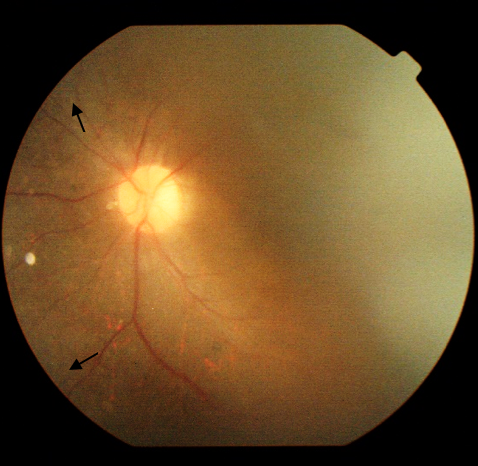Usher Syndrome with Posterior Subcapsular Cataract
Abstract
Introduction: Usher Syndrome (USH) is an autosomal recessive disorder characterized by congenital sensorineural deafness and progressive loss of vision due to retinitis pigmentosa. The aim of this report is to report rare cases of USH by perform diagnostic steps based on clinical examination and family history with expectations that if a similar case is found, an earlier diagnosis and rehabilitation can be done.
Methods: Diagnosis is based on history, ophthalmology examination and ear, nose, and ear (ENT) examination.
Results: A 23-year-old man came to the Ophthalmology Outpatient Department with complaints of bilateral blurred vision especially at night and visual field constriction starting 12 years ago. The patient experienced gradual vision deterioration followed by appearance of white spot in his left eye. Patient is deaf and mute since birth. Three family members of the paternal line exhibit the same symptoms. The best corrected visual acuity was right eye 6/15 and left eye hand movement. Bilateral cataract was found during eye examination. Posterior segment examination revealed peripheral bone spiculae appearance and waxy pallor optic disc in both eyes. Loss of neurosensory layer, worse in the left eye, was discovered through Optical Coherence Tomography (OCT). Humphrey perimetry of the right eye indicated tunnel vision. Examination by otorhinolaryngologist revealed a sensorineural hearing loss. In this patient, there is no management for the disorders due to the poor prognosis of visual acuity. What can be done to improve the patient's quality of life is supportive therapy. It is important to screen and educate families suffering from the same disorder for early diagnosis & rehabilitation.
Conclusion: Clinical examination and family history confirm the diagnosis of USH. Early diagnosis and early rehabilitation are essential to improve patient's quality of life. In this case, no management was carried out for the cataracts because the visual acuity of both eyes did not match the cloudiness of the lens so there are possibility the visual acuity could not improve. Rehabilitations that can be done for the patients are visual and social rehabilitation to improve quality of life.
Full text article
References
Sahu S, Singh SK. Usher syndrome Type I in an adult Nepalese male: a rare case report. Nepalese Journal of Ophthalmology. 2017; 9(2):203-205.
Yan D, Liu XZ. Genetics and pathological mechanisms of Usher syndrome. Journal of human genetics. 2010; 55(6):327.
Millan JM, Aller E, Jaijo T, Blanco-Kelly F, Gimenez-Pardo A, Ayuso C. An Update on the Genetics of Usher Syndrome. Journal of Ophthalmology. 2011; 2011.
Kristiyan T, Dewi NA, Refa S. Usher Syndrome in Two Siblings, A Case Report. International Journal of Retina (IJRETINA). 2019; 02(01).
Liu Y-C, Wilkins M, Kim T, Malyugin B, Mehta JS. Cataracts. The Lancet. 2017; 390(10094):600-612.
David A. Newsome MWJS, Jr, MD; Irene H. Maumenee, MD. Cataract Extraction and Intraocular Lens Implantation in Patients With Retinitis Pigmentosa or Usher's Syndrome. Archives of Ophthalmology. 1986; 104(6):852–854.
Du W. Genetic analysis of a family with Usher syndrome. J International Eye Science. 2018; 18(10):1880-1882.
Mathur P, Yang J. Usher syndrome: hearing loss, retinal degeneration and associated abnormalities. Biochimica et Biophysica Acta -Molecular Basis of Disease. 2015; 1852(3):406-420.
Schietroma C, Parain K, Estivalet A, Aghaie A, de Monvel JB, Picaud S, et al. Usher syndrome type 1–associated cadherins shape the photoreceptor outer segment. 2017; 216(6):1849-1864.
Kimberling WJ, Hildebrand MS, Shearer AE, Jensen ML, Halder JA, Trzupek K, et al. Frequency of Usher syndrome in two pediatric populations: Implications for genetic screening of deaf and hard of hearing children. Genetics in Medicine. 2010; 12(8):512.
Creel DJ. Electroretinograms. In: Handbook of clinical neurology: Elsevier; 2019. p. 481-493.
Sun LW, Johnson RD, Langlo CS, Cooper RF, Razeen MM, Russillo MC, et al. Assessing photoreceptor structure in retinitis pigmentosa and Usher syndrome. Investigative ophthalmology visual science. 2016; 57(6):2428-2442.
Abdelkader E, Enani L, Schatz P, Safieh L. Severe retinal degeneration at an early age in Usher syndrome type 1B associated with homozygous splice site mutations in MYO7A gene. Saudi Journal of Ophthalmology. 2018; 32(2):119-125.
Strong S, Liew G, Michaelides MJBJoO. Retinitis pigmentosa-associated cystoid macular oedema: pathogenesis and avenues of intervention. 2017; 101(1):31-37.
H Jackson DG-H, P Rosen, A C Bird, S J Tuft. Outcome of cataract surgery in patients with retinitis pigmentosa. British Journal of Ophthalmology 2001; 85:936-938.
Jacobson SG, Aleman TS, Sumaroka A, Cideciyan AV, Roman AJ, Windsor EA, et al. Disease boundaries in the retina of patients with Usher syndrome caused by MYO7A gene mutations. Investigative ophthalmology visual science. 2009; 50(4):1886-1894.
Pierrache LH, Hartel BP, Van Wijk E, Meester-Smoor MA, Cremers FP, De Baere E, et al. Visual prognosis in USH2A-associated retinitis Pigmentosa is worse for patients with usher syndrome type IIa than for those with nonsyndromic retinitis Pigmentosa. Ophthalmology. 2016; 123(5):1151-1160.
Gill JS, Georgiou M, Kalitzeos A, Moore AT, Michaelides M. Progressive cone and cone-rod dystrophies: clinical features, molecular genetics and prospects for therapy. 2019; 103(5):711-720.
Ebermann I, Scholl HP, Issa PC, Becirovic E, Lamprecht J, Jurklies B, et al. A novel gene for Usher syndrome type 2: mutations in the long isoform of whirlin are associated with retinitis pigmentosa and sensorineural hearing loss. 2007; 121(2):203-211.
Smith R, Berlin C, Hejtmancik J, Keats B, Kimberling WJ, Lewis R, et al. Clinical diagnosis of the Usher syndromes. 1994; 50(1):32-38.
Authors
Copyright (c) 2022 Bramantya Surya Pratama, Nadia Artha Dewi

This work is licensed under a Creative Commons Attribution-NonCommercial-ShareAlike 4.0 International License.

